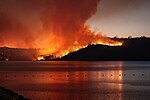North Table Mountain Ecological Reserve
1993 establishments in CaliforniaCalifornia Department of Fish and Wildlife areasCalifornia State ReservesIUCN Category IVLandforms of Butte County, California ... and 6 more
Natural history of the Central Valley (California)Nature reserves in CaliforniaProtected areas established in 1993Protected areas of Butte County, CaliforniaSacramento ValleyWetlands of California

The North Table Mountain Ecological Reserve is a nature reserve of 3,315 acres (13.42 km2) located three miles (5 km) north of Oroville, in Butte County, northern California. The land was acquired by the state in October, 1993.
Excerpt from the Wikipedia article North Table Mountain Ecological Reserve (License: CC BY-SA 3.0, Authors, Images).North Table Mountain Ecological Reserve
North General Sherman Way,
Geographical coordinates (GPS) Address Nearby Places Show on map
Geographical coordinates (GPS)
| Latitude | Longitude |
|---|---|
| N 39.636111111111 ° | E -121.55 ° |
Address
North General Sherman Way
North General Sherman Way
California, United States
Open on Google Maps






